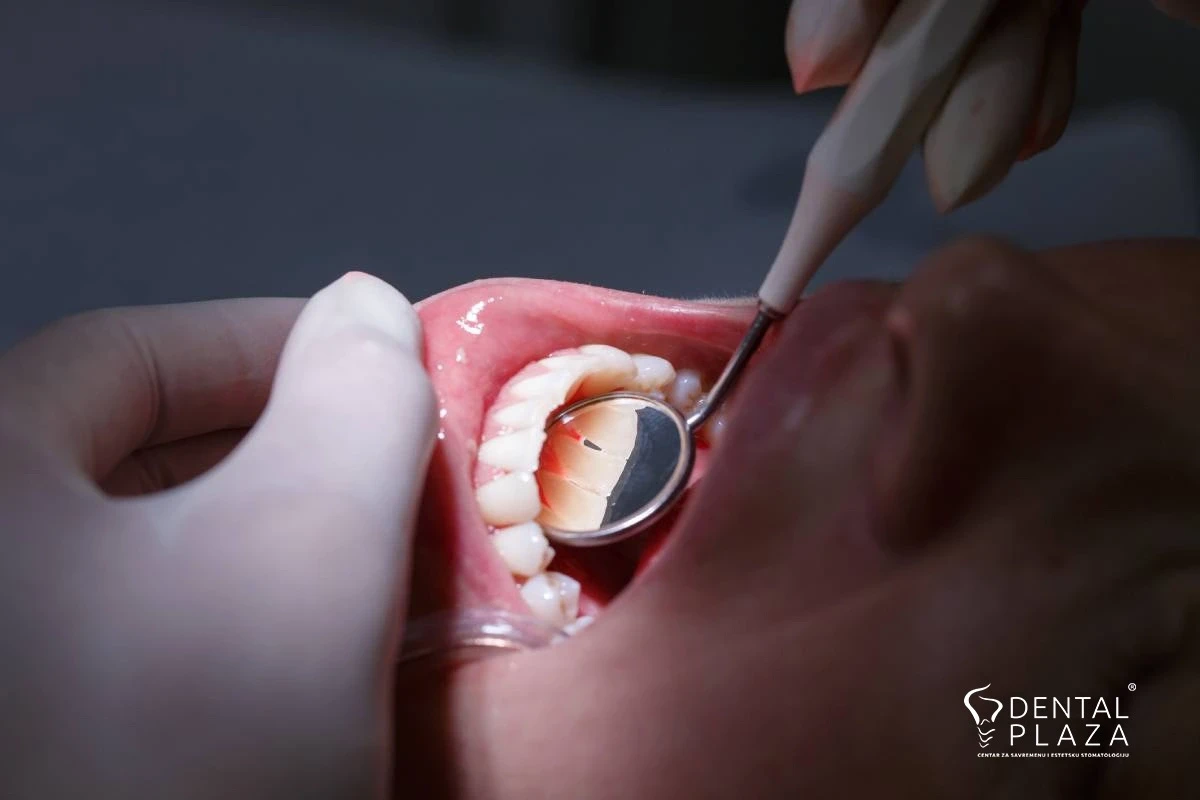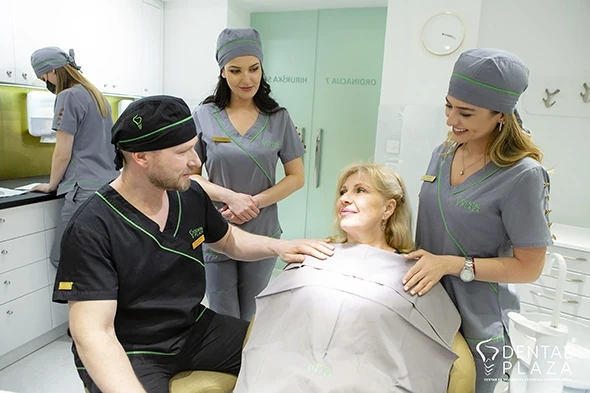Do not be shy, show your teeth!
Call Center 08-21h
Do not be shy, show your teeth!
Call Center 08-21h

Periodontology is a branch of dentistry that deals with diseases of the supporting apparatus of the teeth - the periodontium. The supporting apparatus of the tooth consists of the tissues that surround the tooth, namely the gingiva, tooth cementum, bone and periodontal fibers that connect the tooth to the alveolus (bony cup).
The most common disease of the supporting apparatus of the teeth, and at the same time the most common disease of the dento-facial region, is periodontopathy. Periodontopathy is a progressive, degenerative disease of the periodontium (the supporting apparatus of the teeth), which, over time, can lead to loosen, displacement and the loss of teeth. The most important causative agents of periodontitis are dental plaque microorganisms. Dental plaque is an organic, bacterial, colorless soft deposit that accumulates on the teeth. Improper maintenance of oral hygiene favors the accumulation of dental plaque and accelerates the process of deterioration of the supporting apparatus of the teeth. Factors that significantly contribute to the onset and development of periodontopathy and accelerate tooth decay are smoking, genetic predisposition.
Local factors, which come from the mouth cavity, and contribute to the appearance and faster development of the disease, are the irregular structure of the supporting tissues, inadequately performed prosthetic restorations and dental fillings, food sticking, dental caries, traumatic contacts as well as hard dental deposits (concrements and tartar). That is why we say that problems such as dental plaque, tartar and tooth decay should not be taken lightly.
The therapy of periodontopathy is a laborious process that requires a lot of time, effort and discipline of the patient, where a full cure very often cannot even be achieved, but even just stopping or slowing down the progression of the disease is considered a success.
Treatment of periodontal disease begins with the causal phase. This stage in the therapy involves cleaning soft and hard deposits, as well as treatment of periodontal pockets. All periodontal patients go through this phase of therapy, regardless of the type and severity of the disease. If the disease progresses and there are deep periodontal pockets, the surgical phase of therapy is applied.
.webp)
As part of the causal phase of the therapy, tartar is removed. Tartar is formed by the mineralization of dental plaque. This intervention is most often performed with the help of an ultrasound probe or manually. This is how supragingival concrements and deposits are removed. After each removal of tartar, it is necessary to polish the teeth using a brush and a suitable abrasive paste.
If periodontopathy has progressed, deep periodontal pockets are formed. These are pathologically formed spaces between the teeth and bone walls that must be "cleaned" regularly by the dentist. With the help of appropriate instruments, curettage of periodontal pockets is performed and thus subgingival concrements, i.e. deposits below the level of the gums, as well as the thin surface layer of tooth cement that is affected by infection, are eliminated. Along with the mechanical treatment, the space of the periodontal pocket is rinsed simultaneously, which helps the cleaning process.
Within periodontal surgery, the most commonly applied is the so-called lobe surgery, which cleans periodontal pockets under direct eye control. In the case of deep periodontal pockets, where significant bone resorption is present, a lobe or ''flap'' operation is suggested, with the addition of artificial bone and resorptive membranes. In this way, all pathological granulations and harmful substances accumulated in the pocket are eliminated, and the lost part of the bone is replaced with artificial bone. In this way, the life of periodontal teeth is extended and the further development of periodontal disease is prevented.
Also, this broad area of dentistry also covers interventions that correct soft tissues (gingivectomy, gingivoplasty). In patients who have a "gummy smile", the shape of the gingiva can be corrected surgically or with a laser.

As part of periodontal surgery, clinical dental crown lengthening interventions are also performed. These interventions are applied when the proportion of the width and length of the crown of the tooth is disturbed, which is aesthetically unacceptable. The goal of lengthening the clinical dental crown is to achieve the necessary and harmonious smile through the correct length and proportion of the teeth.
Treatment of exposed root (recession) of tooth is also an area covered by periodontal surgery. In these cases, connective tissue grafts (TVT) or SMAT can be used to cover the exposed part.
In children, frenectomy is most often used, that is, the removal of the fold that connects the upper or lower lip to the gums, as well as the fold that connects the tongue to the floor of the oral cavity.
Do you have questions?

Periodontology is a branch of dentistry that deals with diseases of the supporting apparatus of the teeth - the periodontium. The supporting apparatus of the tooth consists of the tissues that surround the tooth, namely the gingiva, tooth cementum, bone and periodontal fibers that connect the tooth to the alveolus (bony cup).
The most common disease of the supporting apparatus of the teeth, and at the same time the most common disease of the dento-facial region, is periodontopathy. Periodontopathy is a progressive, degenerative disease of the periodontium (the supporting apparatus of the teeth), which, over time, can lead to loosen, displacement and the loss of teeth. The most important causative agents of periodontitis are dental plaque microorganisms. Dental plaque is an organic, bacterial, colorless soft deposit that accumulates on the teeth. Improper maintenance of oral hygiene favors the accumulation of dental plaque and accelerates the process of deterioration of the supporting apparatus of the teeth. Factors that significantly contribute to the onset and development of periodontopathy and accelerate tooth decay are smoking, genetic predisposition.
Local factors, which come from the mouth cavity, and contribute to the appearance and faster development of the disease, are the irregular structure of the supporting tissues, inadequately performed prosthetic restorations and dental fillings, food sticking, dental caries, traumatic contacts as well as hard dental deposits (concrements and tartar). That is why we say that problems such as dental plaque, tartar and tooth decay should not be taken lightly.
The therapy of periodontopathy is a laborious process that requires a lot of time, effort and discipline of the patient, where a full cure very often cannot even be achieved, but even just stopping or slowing down the progression of the disease is considered a success.
Treatment of periodontal disease begins with the causal phase. This stage in the therapy involves cleaning soft and hard deposits, as well as treatment of periodontal pockets. All periodontal patients go through this phase of therapy, regardless of the type and severity of the disease. If the disease progresses and there are deep periodontal pockets, the surgical phase of therapy is applied.
.webp)
As part of the causal phase of the therapy, tartar is removed. Tartar is formed by the mineralization of dental plaque. This intervention is most often performed with the help of an ultrasound probe or manually. This is how supragingival concrements and deposits are removed. After each removal of tartar, it is necessary to polish the teeth using a brush and a suitable abrasive paste.
If periodontopathy has progressed, deep periodontal pockets are formed. These are pathologically formed spaces between the teeth and bone walls that must be "cleaned" regularly by the dentist. With the help of appropriate instruments, curettage of periodontal pockets is performed and thus subgingival concrements, i.e. deposits below the level of the gums, as well as the thin surface layer of tooth cement that is affected by infection, are eliminated. Along with the mechanical treatment, the space of the periodontal pocket is rinsed simultaneously, which helps the cleaning process.
Within periodontal surgery, the most commonly applied is the so-called lobe surgery, which cleans periodontal pockets under direct eye control. In the case of deep periodontal pockets, where significant bone resorption is present, a lobe or ''flap'' operation is suggested, with the addition of artificial bone and resorptive membranes. In this way, all pathological granulations and harmful substances accumulated in the pocket are eliminated, and the lost part of the bone is replaced with artificial bone. In this way, the life of periodontal teeth is extended and the further development of periodontal disease is prevented.
Also, this broad area of dentistry also covers interventions that correct soft tissues (gingivectomy, gingivoplasty). In patients who have a "gummy smile", the shape of the gingiva can be corrected surgically or with a laser.

As part of periodontal surgery, clinical dental crown lengthening interventions are also performed. These interventions are applied when the proportion of the width and length of the crown of the tooth is disturbed, which is aesthetically unacceptable. The goal of lengthening the clinical dental crown is to achieve the necessary and harmonious smile through the correct length and proportion of the teeth.
Treatment of exposed root (recession) of tooth is also an area covered by periodontal surgery. In these cases, connective tissue grafts (TVT) or SMAT can be used to cover the exposed part.
In children, frenectomy is most often used, that is, the removal of the fold that connects the upper or lower lip to the gums, as well as the fold that connects the tongue to the floor of the oral cavity.